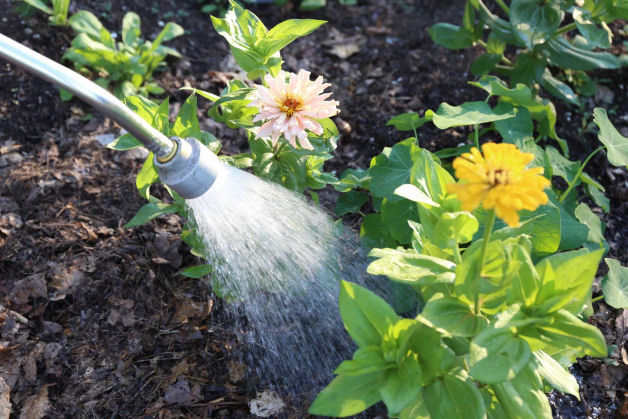After all the trips you’ve made to the garden center, and all of the flowers and vegetables have been planted into the garden, many gardeners feel that their work is done. Now is the time to sit back and enjoy all your hard work. Yet, when Mother Nature turns up the heat in your garden, it’s time to get watering! To some, watering is a chore, but to others it can be a calming end of the day activity.
The single most important rule of irrigation is when you water … water well! Water needs to saturate the soil and come in contact with the roots in order for it to be taken into the plant and used for plant growth or to help with flower/fruit or veggie production. Watering is of no value if the water runs down the outside of the root ball, leaving the roots at the core of the plant dry. This can happen if you water too quickly or apply too much water at once. Slower watering is usually more effective. The key is to ensure that water gets to the root zone — whether you are tending seedlings, watering houseplants, watering a row of tomatoes or soaking thirsty shrubs and trees.
It is far better to water well but infrequently than to water too little but often. Plants that are watered often with just a bit of water will develop a shallow root system. Watering in this manner will tell the plant that it has no need to develop a deep root system. Then if water becomes less plentiful the plant doesn’t have a deep enough root system to stay alive much less thrive with flowers or fruit.
You should try to water in the early morning or at the latest by noon. Wet plants at night that have standing water around them are much more susceptible to diseases. Of course, there are exceptions to every rule. If you have to water to save a plant from drying go ahead and water. The immediate concern is more important than the possibility of disease. If you must water because evening is the only time you have in the garden, try to water so that the soil is moist but not the plant. Water closer to the ground and not from overhead getting the leaves wet.
Six Tips For Watering Your Garden
1. Focus on the root zone. Remember that it’s the roots that need access to water, not the leaves. Wetting the foliage is a waste of water and can promote the spread of disease.
2. Water only when needed. Automatic watering timers are especially useful; just make sure to watch the weather, and reduce frequency when rainfall is abundant. Too much moisture can be just as damaging to plants as too little.
3. Water deeply and thoroughly. Lawns and annuals concentrate their roots in the top 6″ of soil; for perennials, shrubs and trees, it’s the top 12″. In heavy soil, it may take hours for water to percolate down 6-12″. Use your finger or a shovel to check the progress.
4. Water in the morning. If you do get moisture on the leaves, this gives them time to dry out. It’s much more difficult for plant diseases to get a foothold when the foliage is dry.
5. Mulch everything. Mulch reduces surface runoff and slows evaporation from the soil.
6. Use the right tool. For efficient watering at the root zone, use a soaker hose or an even more precise drip irrigation system instead of a sprinkler.

